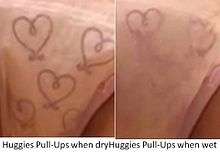Wetness indicator
A wetness indicator is a common feature in many disposable diapers and toilet training pants. It is a feature that reacts to exposure of liquid as a way to discourage the wearer to urinate in the training pants, or as an indicator for parents that a diaper needs changing.[1][2]
Types
- "Fade when wet" is a feature in most training pants that has small graphics which fade as a reaction to liquid, specifically urine.[3]

- "Feel wet" is a feature used in some training pants that lets the wearer know when she is wet by feeling. Nowadays few training pants use this feature.
History
In 1978, Kimberly-Clark introduced Kleenex Super Dry diapers with "wetness indicators" in the form of a design that fades and lightens as the inside of the diaper becomes wetter.[4][5] (The Kleenex Super Dry line was later superseded by Kimberley-Clark's higher-end "Huggies" line.[6][7])
In 2000, Huggies introduced and started integrating their new "Learning Designs" feature into all Huggies Pull-Ups training pants. These were small designs on the Pull-Up that use a special ink that fades when exposed to wetness, with an intent to let the wearer know when the wearer is wet or dry and as an incentive for urinating in the toilet instead of in the Pull-Up.[8] But on March 2nd, 2005, the original Huggies Pull-Ups are now known as Learning Designs. Learning Designs Pull-Ups also have a small star picture on the inside that is digested on, that is also printed on certain ink that evaporates when exposed to feces.[9]
In 2002, Pampers introduced Easy Ups trainers, which adopted the Learning Designs technique from Huggies Pull-Ups.
In 2004, Pampers introduced Feel 'N Learn trainers, which not only used the Learning Designs, but also added a wetness liner that lets the wearer know when she is wet by feeling.
In 2005, Huggies released Pull-Ups Training Pants with Wetness Liner, similar to Pampers's Feel 'N Learn.
References
- ↑ The Choice Guide to Baby Product: The Buying Guide for Parents. Choice Books. 2012. p. 55. ISBN 978-1459603424.
- ↑ "What are the components used on a typical disposable diaper". Diaper Industry Source. 2009-02-14. Archived from the original on 2011-07-23.
- ↑ The Intrepid Parent's Field Guide to the Baby Kingdom. Adams Media Corporation. 2012. p. 92. ISBN 978-1440554483. Retrieved 23 December 2012.
- ↑ Schewe, Charles D.; Smith, Reuben M. (1980). Marketing: concepts and applications. New York: McGraw-Hill. p. 10. ISBN 9780070552722. Retrieved 23 December 2012.
- ↑ Incentive Marketing. Bill Publications. 157: 38 https://books.google.com/books?id=nTMcAQAAMAAJ. Retrieved 23 December 2012. Missing or empty
|title=(help) - ↑ Spector, Robert; Wicks, William W. (1997). Shared values: a history of Kimberly-Clark. Lyme, Connecticut: Greenwich Publishing Group. p. 112. ISBN 9780944641170. Retrieved 24 December 2012.
- ↑ Paper Trade Journal. Vance Publication. 162: 29. ISSN 0031-1197 https://books.google.com/books?id=40lQAAAAYAAJ&q=%22super+dry%22#search_anchor. Retrieved 24 December 2012. Missing or empty
|title=(help) - ↑ "Huggies Pull-Ups® KIWI". 2000-08-17. Archived from the original on August 17, 2000. Retrieved 2016-04-11.
- ↑ "PULL-UPS® Training Pants presents the Way to Go!™ Potty Training Success Guide - No One Helps Make Potty Training Easier!". 2006-01-11. Archived from the original on January 11, 2006. Retrieved 2016-06-20.
